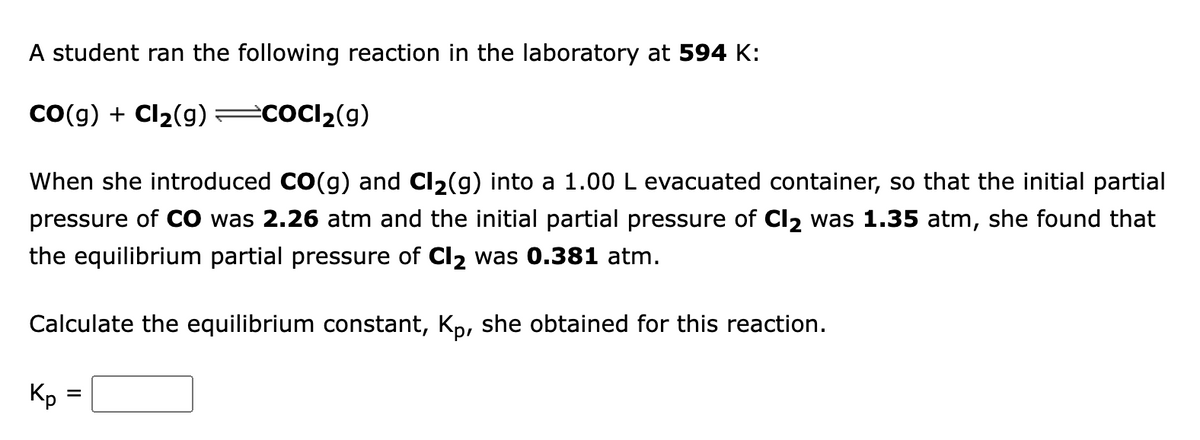A student ran the following reaction in the laboratory at 696 K: 2HI(g) H2(g) + I2(g) When he introduced HI(g) at a pressure of 3.40 atm into a 1.00 L evacuated container, he found the equilibrium partial pressure of HI(g) to be 2.68 atm. Calculate the equilibrium constant, Kp, he obtained for this reaction. Кр
A student ran the following reaction in the laboratory at 696 K: 2HI(g) H2(g) + I2(g) When he introduced HI(g) at a pressure of 3.40 atm into a 1.00 L evacuated container, he found the equilibrium partial pressure of HI(g) to be 2.68 atm. Calculate the equilibrium constant, Kp, he obtained for this reaction. Кр
Chemistry: The Molecular Science
5th Edition
ISBN:9781285199047
Author:John W. Moore, Conrad L. Stanitski
Publisher:John W. Moore, Conrad L. Stanitski
Chapter19: The Chemistry Of The Main-group Elements
Section: Chapter Questions
Problem 60QRT
Related questions
Question
100%

Transcribed Image Text:A student ran the following reaction in the laboratory at 696 K:
2HI(g) H2(g) + I2(g)
When he introduced HI(g) at a pressure of 3.40 atm into a 1.00 L evacuated container, he found
the equilibrium partial pressure of HI(g) to be 2.68 atm.
Calculate the equilibrium constant, Kp, he obtained for this reaction.
Kp =

Transcribed Image Text:A student ran the following reaction in the laboratory at 594 K:
Co(g) + Cl2(g) =cOCl2(g)
When she introduced CO(g) and Cl2(g) into a 1.00 L evacuated container, so that the initial partial
pressure of CO was 2.26 atm and the initial partial pressure of Cl2 was 1.35 atm, she found that
the equilibrium partial pressure of Cl2 was 0.381 atm.
Calculate the equilibrium constant, Kp, she obtained for this reaction.
Kp
%D
Expert Solution
This question has been solved!
Explore an expertly crafted, step-by-step solution for a thorough understanding of key concepts.
Step by step
Solved in 2 steps with 2 images

Knowledge Booster
Learn more about
Need a deep-dive on the concept behind this application? Look no further. Learn more about this topic, chemistry and related others by exploring similar questions and additional content below.Recommended textbooks for you

Chemistry: The Molecular Science
Chemistry
ISBN:
9781285199047
Author:
John W. Moore, Conrad L. Stanitski
Publisher:
Cengage Learning

Chemistry & Chemical Reactivity
Chemistry
ISBN:
9781133949640
Author:
John C. Kotz, Paul M. Treichel, John Townsend, David Treichel
Publisher:
Cengage Learning

Chemistry & Chemical Reactivity
Chemistry
ISBN:
9781337399074
Author:
John C. Kotz, Paul M. Treichel, John Townsend, David Treichel
Publisher:
Cengage Learning

Chemistry: The Molecular Science
Chemistry
ISBN:
9781285199047
Author:
John W. Moore, Conrad L. Stanitski
Publisher:
Cengage Learning

Chemistry & Chemical Reactivity
Chemistry
ISBN:
9781133949640
Author:
John C. Kotz, Paul M. Treichel, John Townsend, David Treichel
Publisher:
Cengage Learning

Chemistry & Chemical Reactivity
Chemistry
ISBN:
9781337399074
Author:
John C. Kotz, Paul M. Treichel, John Townsend, David Treichel
Publisher:
Cengage Learning

Chemistry: Principles and Practice
Chemistry
ISBN:
9780534420123
Author:
Daniel L. Reger, Scott R. Goode, David W. Ball, Edward Mercer
Publisher:
Cengage Learning

General Chemistry - Standalone book (MindTap Cour…
Chemistry
ISBN:
9781305580343
Author:
Steven D. Gammon, Ebbing, Darrell Ebbing, Steven D., Darrell; Gammon, Darrell Ebbing; Steven D. Gammon, Darrell D.; Gammon, Ebbing; Steven D. Gammon; Darrell
Publisher:
Cengage Learning

Chemistry for Engineering Students
Chemistry
ISBN:
9781337398909
Author:
Lawrence S. Brown, Tom Holme
Publisher:
Cengage Learning